"Catacomb saints" with via Salaria: brisk business on precious remains
Categories: Europe | Science | World
By Pictolic https://pictolic.com/article/catacomb-saints-with-via-salaria-brisk-business-on-precious-remains.htmlVeneration of the relics of the saints, the righteous and martyrs exists in almost all religions of the world. But especially in demand remains Orthodox and Catholics. Business on the relics of the saints and the righteous exists virtually since the advent of Christianity and prospers still. Flourishing trade of relics flourished in the Middle ages, and the best example of this "business" can be called the sale of "catacomb saints" of Rome. (Caution! Shocking content).
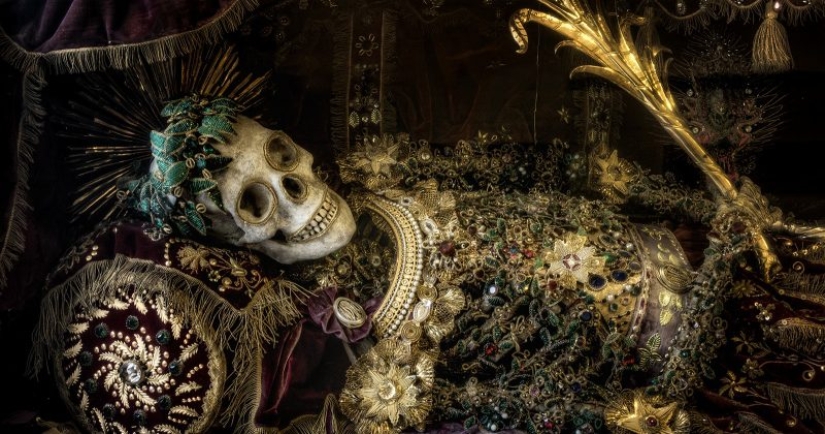
The story of the remains from the catacombs of Rome became public thanks to the photographer and art critic Koudounaris Floor, nicknamed ' Indiana bones (Indiana Bones). This strange type has dedicated his life to the study and photographing of relics, ossuaries, reliquaries and just human remains, which are associated with legends and ancient rites.
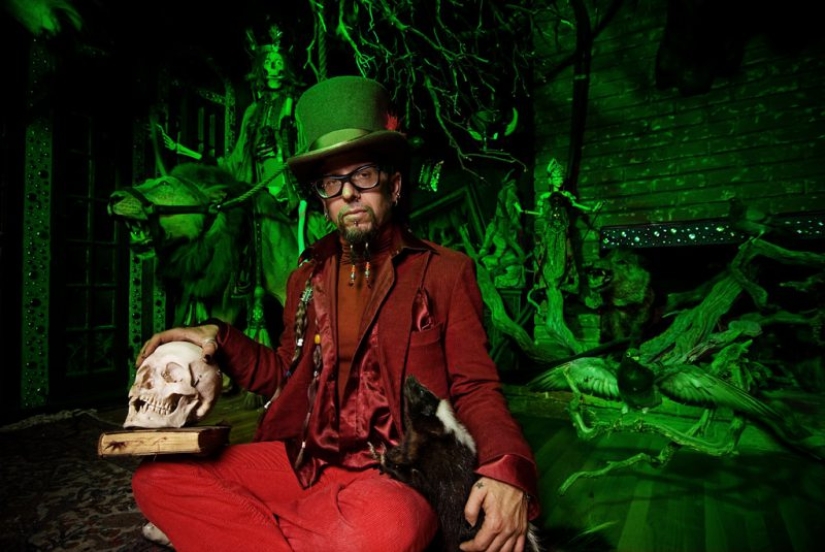
Paul Koudounaris
In 2008, during one of my trips to Germany, to the Floor went local. He said Koudounaris that familiar with his research and wants to show unusual relic, hidden in an old forest chapel. Of course, the scientist agreed and did not regret the time spent.
In miniature, partially destroyed the chapel, hidden in the forests close to the Czech border, a new friend of mine showed Sex niche, boarded up. Koudounaris looked in the crack and saw that the darkness was looking at him with red eyes grinning human skull.
Carefully removing the boards, the researchers found in a niche upright skeleton, dressed in Royal clothes. At the head of the corpse was richly embroidered tiara, and in his hand he held a glass vial. A man who possessed a chapel, said that the vessel symbolizes the blood of the deceased and, perhaps, was once filled with her.
After seeing the strange occupant of the chapel, Koudounaris decided that he was dealing with some local custom, typical for this region. But, having an interest in the matter, he was surprised to learn that Germany is precious skeletons is absolutely commonplace. After this the Floor was found a richly decorated skeletons in different parts of the country and each time were surprised at the luxury and precision of the work of old masters that adorned the dead body.
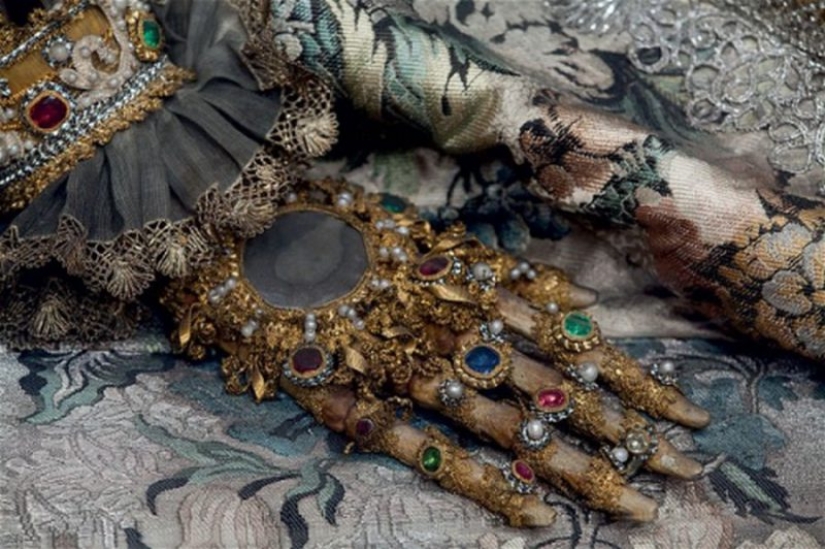
Floor Koudounaris just working on a book about the ossuary "Empire of Death" (Paul Koudounaris. The Empire of Death: A Cultural History of Ossuaries and Charnel Houses), these findings proved very useful. The researcher began to investigate the history of the remains and learned that they all arrived to Germany from Italy a few centuries ago.
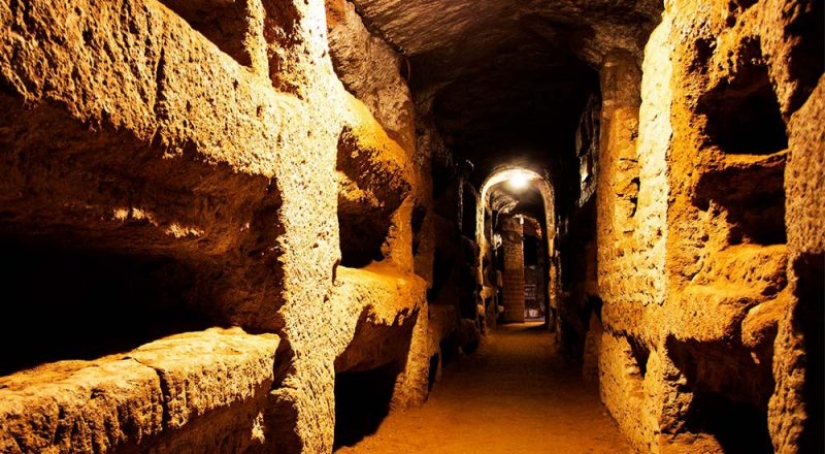
That is why the catacombs were filled with a variety of skeletal and mummified corpses, the number of which shocked the world. Several hundreds of the most well preserved skeletons of 500-700 thousand found in dungeons very quickly found practical application.
The Vatican immediately recognized about the discovery and quickly realized that there is a new way to carry the flame of faith around the world, and at the same time to replenish the Treasury. Nobody knows what kind of people belonged to old skeletons, but in the residence of the Pope sensibly decided that the relics must have belonged to the first Christian martyrs hiding in the catacombs.
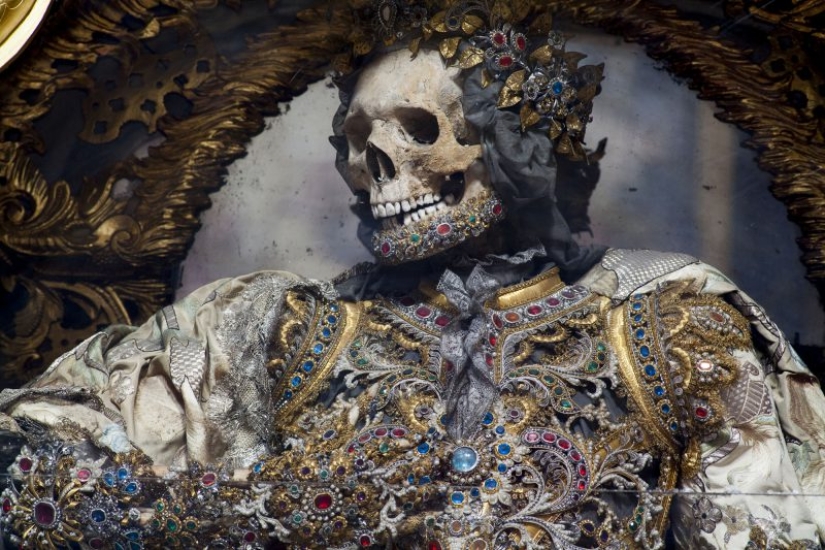
The discovery was very useful, because in front of the Church faces the issue of relics in Germany. Where Protestants have been fighting against the inherent Catholicism of luxury, not shrinking, in this case, the looting of Church property. Relics of saints, extracted from the precious salaries and ark, were ruthlessly thrown out by the reformers of Christianity, so hundreds of churches and cathedrals were without their relics, attracting believers.
"Catacomb saints" with via Salaria quickly become a hot commodity in the German cities and villages. In each ward wanted at least one, better several martyrs from Rome. Of course, relics were distributed, and sold the enterprising papal agents. In village churches of Germany collected money for the "saints" among the parishioners, and the city councils were looking for patrons and plagued mayors — each was seeking funds as they could.
Soon to the undivided use of the personal Holy wished and wealthy families — the skeleton via Salaria was purchased for home chapels and churches. Not far behind, and artisans with merchants — guilds and Guild cooperated and gained his personal patron, to which was annexed a big name and a invented by monks a sentimental and didactic story.Wishing it was a lot, and the number of goods is limited so in the course were personal connections at the papal court, intrigues and, of course, bribes. After the price was agreed upon and a Deposit given to the seller, special couriers-the monks did the delivery from the warehouse of the Vatican to the North of Europe.
In the way of service delivery appeared often dashing rogues, and then the body has a chance to disappear without a trace, finding themselves in a roadside ditch. Sometimes the relic had to buy gentlemen of fortune or even to take by force using guards and even the troops. In General, it was not perishable, but delivers trouble the product, however, profit from trading of skeletons from the catacombs to compensate for all the costs and inconvenience.
Initially, Koudounaris aimed to find out the market turnover of the relics in the sixteenth century, but soon gave up on this venture hand. Accounting the Vatican was incomplete and confusing. The floor was only to find out that in Germany, Austria and Switzerland was sent about 2 thousand complete skeletons. How many bodies went out parts, most likely, will never succeed.
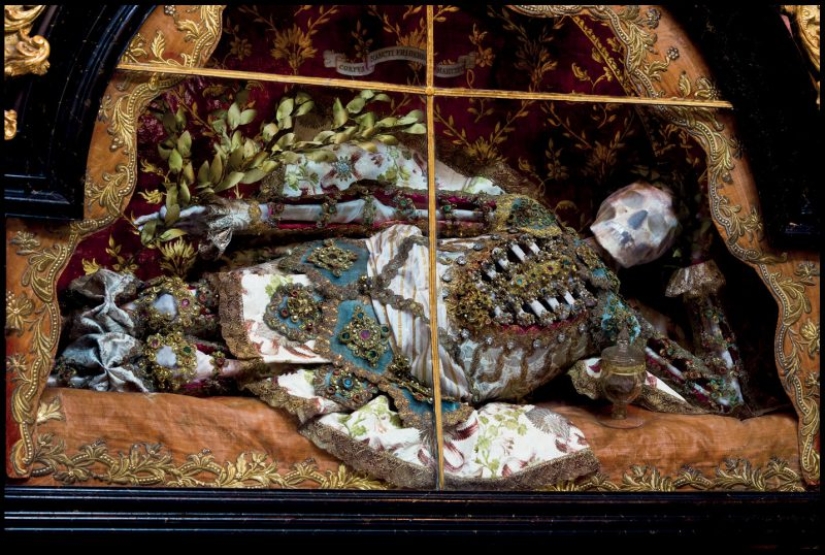
But it was possible to determine how the clergy identified the remains, meant to be implemented. Nameless skeletons, even from the dungeons of the Eternal city, few people were interested — believers needed the early Christian saints and martyrs. Immediately it should be said that the body via Salaria could belong not only to Christians but also Jews, barbarian Gentiles or to anybody.
But the Vatican this option is not satisfied, so I had to come up with a slender and logical system of identification of Christian saints, who are willing to believe both buyers and end consumers, that is, the parishioners. All the bodies found were carefully examined for inscriptions and initials, and when detected, it was very simple.
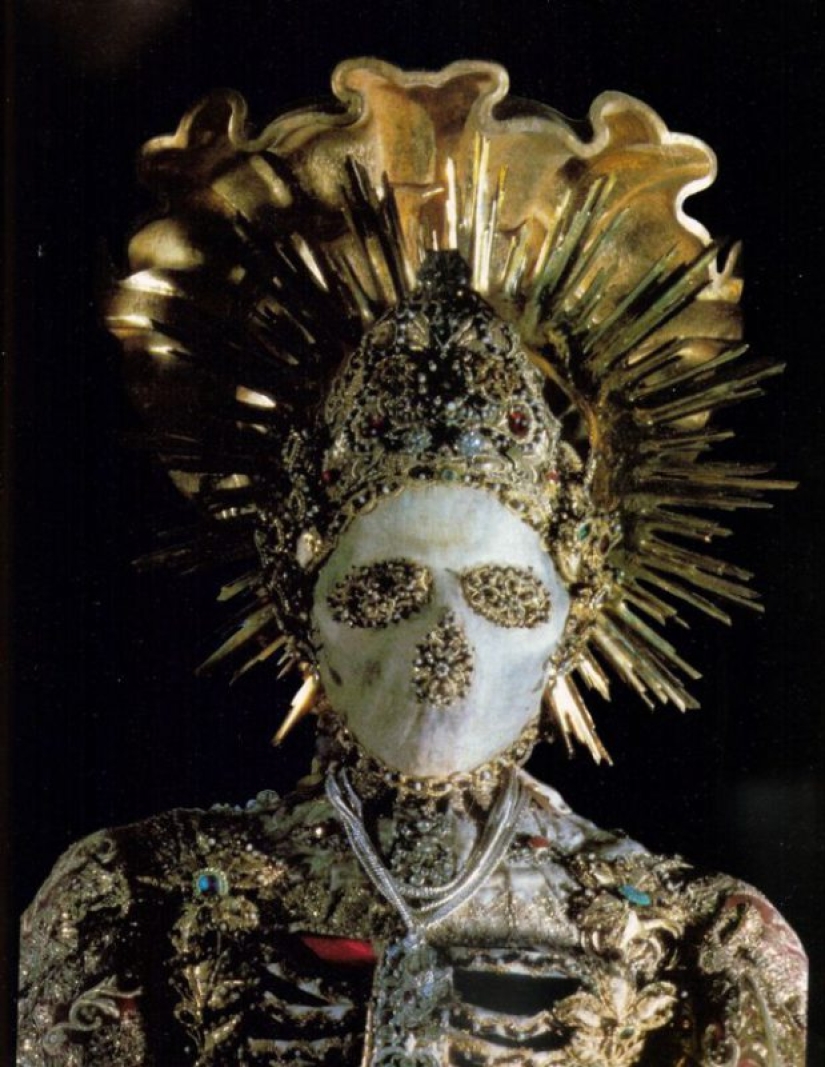
Found on burial shrouds, tombstones and ornaments the letter "M" interpreted as a "martyr", that is, the Martyr and the possibility that this may be the first letter of the name mark or even Moses, the medieval had not been peer reviewed. The bottle in his hands could only mean the blood of a Martyr, although it is more logical to assume that the inside would be incense.When obvious signs of Holiness were really bad, the monks were determined visually martyrs, the Golden effulgence of their power is radiated in the strength of his Holiness. Ordinary people contemplation this effect was not available, so exposing hypocrites, counterfeiters are not too afraid.
Sometimes the problem was solved simply — someone from the Commission came in a dream the Holy one himself, and talked in detail about his penances. This method of determining the owner of the relics were considered less proven than it is today DNA analysis. Few people had the courage to doubt that the representative of the Pope speaks the truth.
Quite unsuitable for demonstration and transportation to Germany of the body are rejected and recognized by the Gentiles, and their entire parts were changed owner and was decent, incorruptible skeleton presentation. Often found and fully consolidated the saints, made up of the surviving parts of a dozen bodies.
Paul Koudounaris described how he could look like getting relics in the sixteenth century:
Brought from Rome in the disassembled view of a skeleton collected at the local monastery, guided by its sometimes dubious knowledge of human anatomy. After examining hundreds of skeletons in various cities of Europe, Koudounaris've seen a lot of strange decisions and unusual substitutions.
Obtained from the Vatican the skeleton of a Martyr already had a name and history, but still looked clumsy. The congregation and the more solid supporters might question what the money paid? Therefore, before presenting the relics to the General public, they are carefully decorated.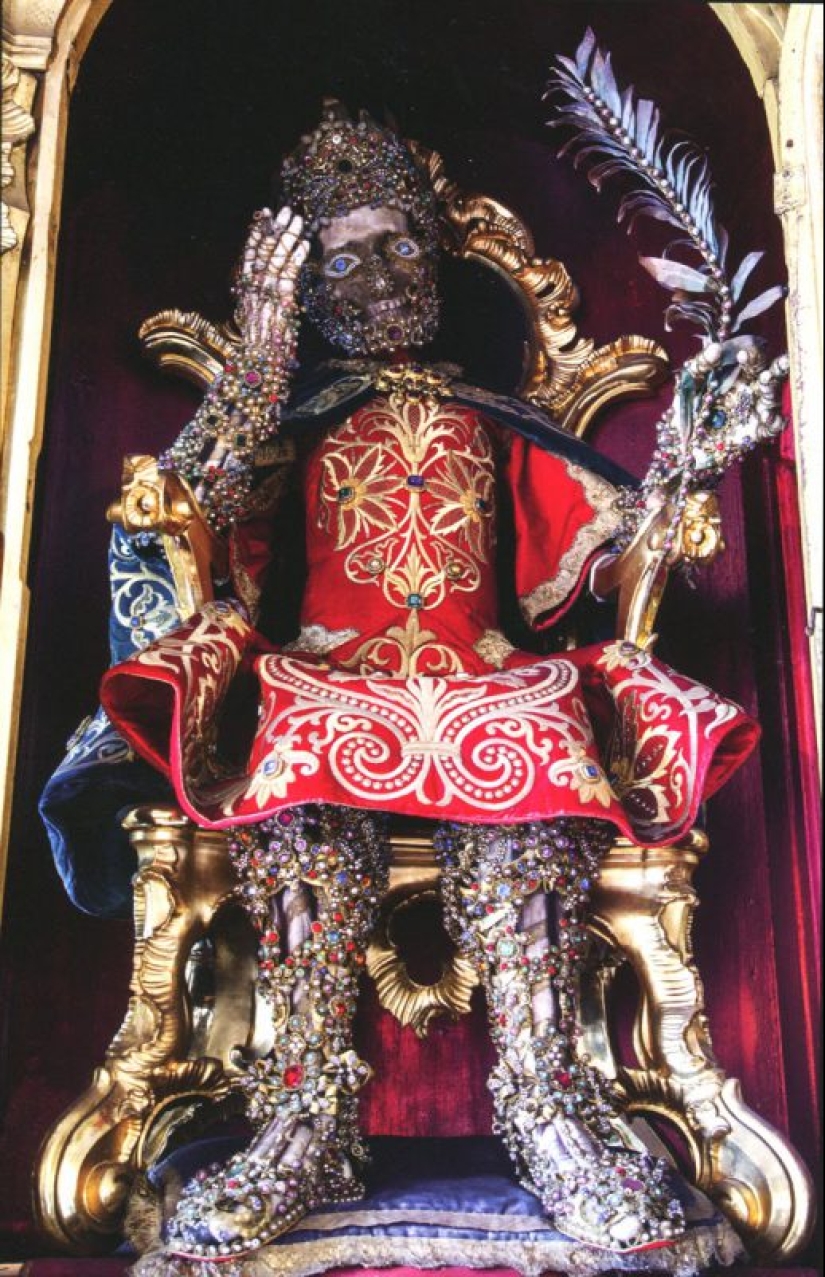
There were gold, silver, glass, porcelain and, of course, precious and semi-precious stones. The work was done by the monks themselves, many of whom were virtuoso artists and real talents. Some skeletons are prepared for a "presentation" more than three years and did this for a few specialists in different fields.
In different monasteries used their special techniques and Koudounaris was able to set aside some special schools having own style in the decoration of corpses. The names of the craftsmen to know we were not always successful, but the work of some craftsmen, the researcher learned to recognize by style.
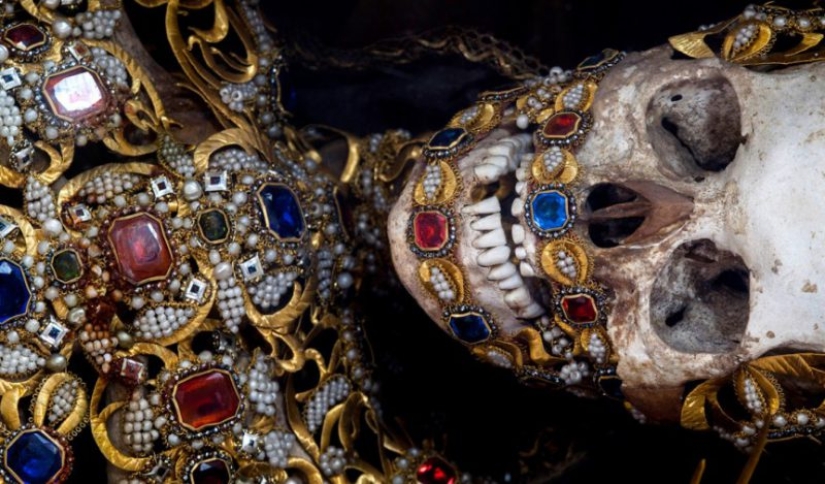
Nuns made embroidered with gold and stones clothing. In addition, women used a special method of packing of the skeleton — every bone tight fitting fine mesh fabric, to protect the relics from contamination and allows easy to secure the decorations where it is needed.
Value for decoration rarely took of the monastery's treasures — usually it was the donations of the faithful. The nobles complain about their ceremonial costumes and decorations, poorer people brought fabric and different valuable things. Sometimes the nuns donated their bodies rings — the idea that a family ring strung on the Saint's bones are very amused.
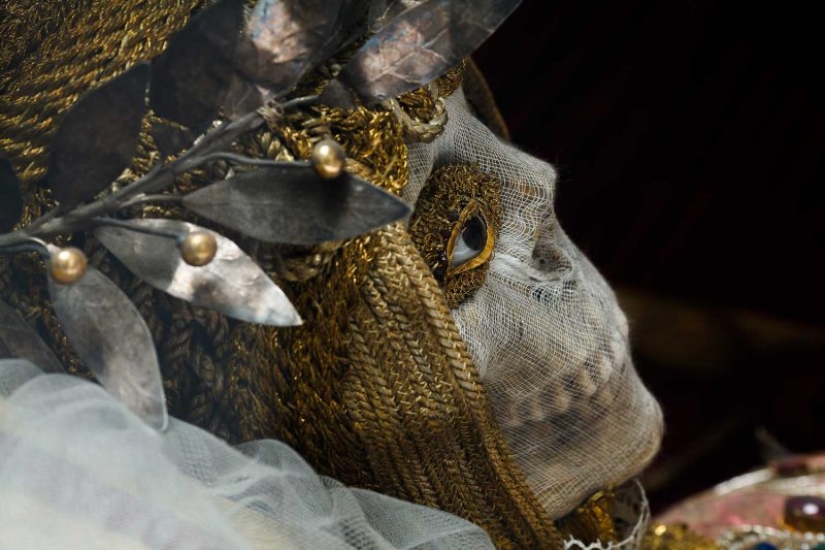
Shortages in materials for the work and sometimes the masters had to leave in the tissues of the gaps that the public was clear that a cascade of brocade sewn gold ducats after all the real bones and not a replica. Although the accuracy was worried not all people. Koudounaris found several skeletons, which produced waxy "masks" depicting a sense of peace and satisfaction from a sense of Christian duty done.He suggested that in some cases, the mask hid unpresentable skull and were designed to make the grin of death is not so terrible. When this is achieved the opposite effect and these relics with doll faces looked the most frightening.
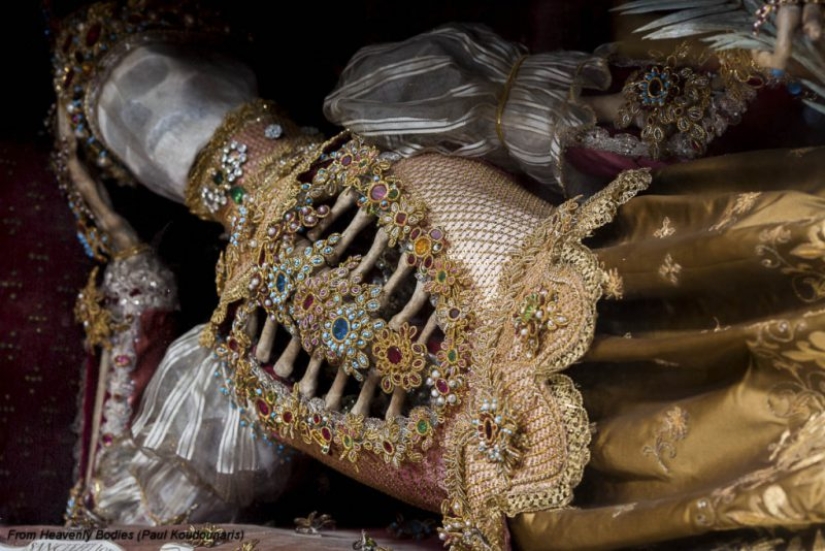
In their study, Paul Koudounaris noted that the strange tradition of decorating the dead fits into the paradigm of the Baroque. According to him, passing through the hands of masters, the bones of unknown people of ancient Rome are true works of art worthy of serious study.
What was the fate of "catacomb saints"? From the workshops of the monasteries they went to churches and cathedrals, where their arrival was expected with a special look. On the occasion of receiving the Holy organized a big feast, which could last for several days.
The skeleton in the precious decoration was placed in a place of honor in the temple, and near them are constantly crowded afflicted. Often such a Saint was declared the patron Saint of the city, making it an indispensable party to all municipal activities. The first child appeared on the receipt after the discovery of relics of, certainly was called in honor of the Martyr. There have been specific cases of religious ecstasy, when born within a few months the kids were namesakes.
In many churches there was a "book of miracles", where recorded in detail all the acts of the Holy. Also, the skeleton was fixed precious signs and tokens, in which the patron Saint was thanked for miraculous healing, the end of the epidemics, the return loss and the cessation of bloodshed. Particularly successful martyrs have dozens of such distinctions.
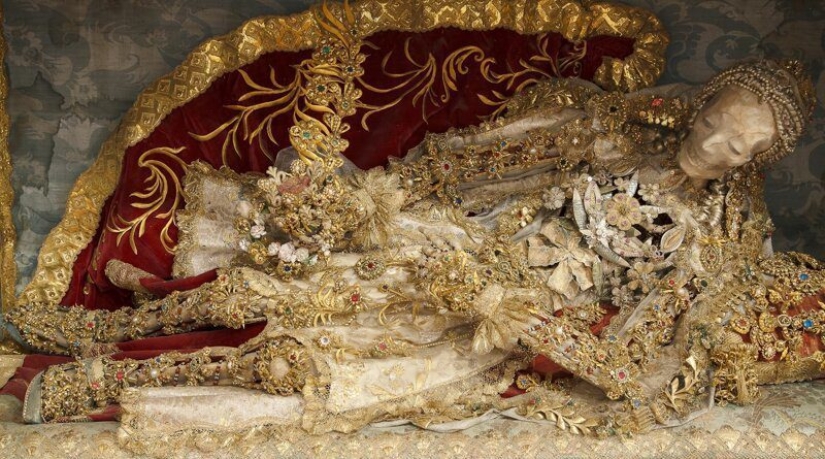
The Enlightenment put an end to these saints. Voltaire wrote about the "catacomb saints," how about barbarism, ridiculing their luxury and people, they are worshiped. At the end of the XVIII century king of Germany, Joseph II issued a decree in which churches and monasteries were ordered to get rid of relics of dubious origin. Of course, the first under the act hit the saints in Golden vesture. Skeletons were removed from their pedestals and carried them to the basement, nailed into the niches of boards, and in the worst case, looted and destroyed.
Keywords: Catacombs | Roman Catholics | Rome | Shrines | Skeletons | Temple
Post News ArticleRecent articles

We present you a selection of amazing beaches — but today these are not standard holiday destinations, but really unusual places. ...

Aerial photographer cronista johnny Miller demonstrate dramatically the gap between rich and poor in cities of South Africa, Mexico ...
Related articles

Polish photographer Sebastian Luzhivo (Sebastian Luczywo) walked around Rome in November, when a cyclone rained heavily on the ...

For many years, we were taught that even in the 19th century, a person was considered an old man at the age of 30, and life ...

Photographer Paolo di Paolo did a lot of wonderful pictures dedicated to his native Italy. He was acquainted with many celebrities ...

On April 22, 1923, Bettie Page was born in Nashville, who became a sex symbol throughout the country in the middle of the century. ...